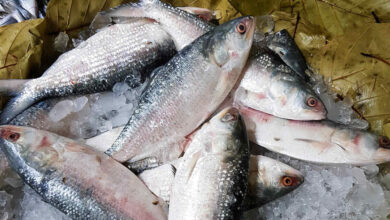
Exporting Hilsa to India from Bangladesh is a longstanding tradition during Durga Puja celebrations. It has resumed in the fiscal year 2019-20 after a break from 2012 to 2018. For the past four years, the Commerce Ministry has exclusively permitted exports to India during the Durga Puja season.
The Commerce Ministry is currently evaluating numerous requests and is on the verge of granting approvals following a comprehensive review, according to Mirajul Islam, the joint secretary of the ministry’s export division. He stressed the thorough scrutiny of applications, with a preference for those who received export permissions in the previous year or those who were unable to export altogether.
While Hilsa is also found in neighboring countries such as India, Myanmar, Pakistan, Iran, Indonesia, Malaysia, and Thailand, Bangladeshi Hilsa stands out for its superior taste and flavor.
In anticipation of the upcoming “Durga Puja” festival of West Bengal in October, around 30 applications for Hilsa exports have been submitted to the Commerce Ministry. In the previous year, 67 traders were granted permission to export a total of 3,350 tons of Hilsa in two phases, each phase involving the export of 50 tons to India. This year, a significant number of businesses have applied for permission to export 100 tons each.
In the last fiscal year, these 67 companies were authorized by the Commerce Ministry to export 3,350 tons of Hilsa. However, the actual exports amounted to only 1,352 tons, generating approximately US $13.26 million (Tk 131.53 crore), as reported by the Export Promotion Bureau (EPB).
During the fiscal year 2021-22, more than 200 businesses sought Hilsa export permits, and the ministry granted permission to 115 exporters for a total of 4,600 tons. Nonetheless, actual exports were limited to just 1,108 tons and 280 kg due to supply shortages, resulting in earnings of about US $12.26 million (Tk 105.87 crore).
In the fiscal year 2020-21, 1,450 tons of Hilsa were exported, with 18 companies securing export permission. An additional 400 tons were subsequently exported, contributing to total earnings of approximately US $16.43 million (Tk 139 crore).
In FY 2019-20, Bangladesh allowed the export of 500 tons of Hilsa, with only one business obtaining export permission. According to EPB data, the country earned around US $16.19 million (Tk 137.32 crore) from Hilsa exports during that financial year.
Members of the Bangladesh Frozen Food Exporters Association and various exporters have pointed out that many recipients of Hilsa export permissions in recent years were not genuine fish exporters. Out of the 57 establishments approved last year, only 4 were regular fish exporters. Despite receiving governmental approval, most trading companies encountered challenges in exporting Hilsa promptly.
Simultaneous exports to the Indian market also resulted in lower prices. Indian importers mostly use LCs (letters of credit) for fish imports but delay settling them, causing delays in payments for Hilsa sales. This payment delay caused several exporters to fall short of completing their exports despite having permission.
Over the past decade, Hilsa production in the country has nearly doubled, surging from 298,000 tons in 2008-09 to 565,000 tons in FY 2020-21.




